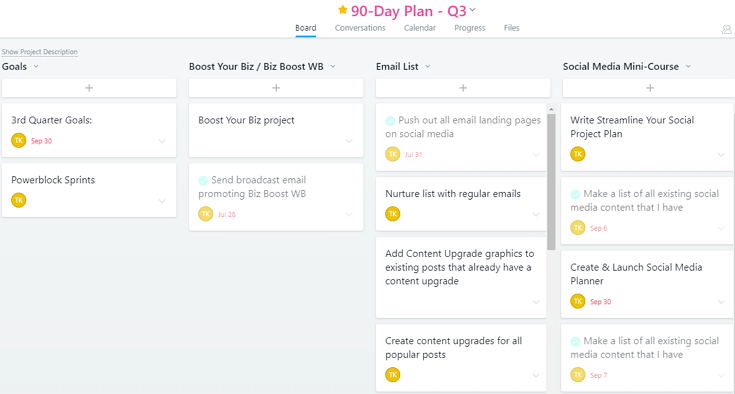Unlock the Power of the 90 Day Business Plan
90-day business plans are all the rage and for good reason. 90 days is short enough that you don’t lose focus but long enough that you can make significant progress toward goals. It’s really the perfect amount of time for a plan.
When I worked in the corporate world, we created detailed business plans at the first of the year that laid out strategies and tactics for the whole year, adding timelines all the way through December.
We spent massive amounts of time and manpower on this exercise. And then a few months or even weeks later, something changed and all the sudden we had new priorities. Those carefully crafted plans had to be redone.
It was crazy!
In this fast-paced world, strategies or tactics that you decide on at the beginning of the year may be outdated a few months later. A better system is to create a very high-level annual plan and save the details for your 90 day plan. Breaking your annual plan into 90-day plans gives you the flexibility you need to achieve your goals.
A 90-day plan also helps you gain momentum. You don’t want to wait until the end of the year to see results, do you? No, you want to see success early in the year, and regularly thereafter, because that will keep you motivated to keep going.
Here’s the process that I follow when crafting a new 90-day business plan.

This post contains affiliate links, which means I receive a small commission if you make a purchase using this link. For more information, see my full disclaimer here.
Review and reflect on the last 90 days
If you haven’t reviewed your progress, then that’s the place to start. Look back at the previous 90-day period. Which goals are on target and which do you need to focus on? Think about what’s working well and what needs improvement. Also, look at your plan from last quarter. Did you accomplish everything on your list?
One of the things I learned in a previous review is that I hadn’t been referring back to my 90-day business plan during the quarter. I wrote the plan and stuck it in my Filofax, but I don’t think I looked at it again. As a result, I felt scattered and unfocused.
Now, I keep my 90-day plan in an Asana board, so it’s always just a click away.

Your 90 day plan should be an extension of your annual plan
Once you’ve reviewed the last quarter, it’s time to take a look at your annual goals. Compare where you are now with what you need to accomplish the remainder of the year. By keeping an eye on your annual goals, you can adjust your quarterly plan as needed. Achieving your 90-day goals puts you on track to achieve your annual goals.
Related Post
If you find yourself getting caught up in all the things you “have to do” each day, then click thru to learn how to see the big picture in your small business.
However, you don’t have to include every category from your annual plan in your 90-day business plan. There may be areas that you are going to focus on more in the 1st quarter than the 3rd, etc. For example, launching a course may be in your 3rd quarter plan, but your priority in the 1st quarter was to hire a VA.
There may also be seasonal considerations in your planning. Are you going to take time off during the current 90 day period? If so, an item on your 90-day plan might be to have enough blog posts and newsletters pre-written to cover the time that you are on vacation so that you can relax and enjoy yourself.
Don’t be afraid to include personal goals
I’ve written before about my quest for work + life balance. I spent too many of my corporate years neglecting my personal life in favor of work. I know that in order to achieve any semblance of balance, I need to include non-business goals & strategies in my plans.
My plan includes physical goals, goals related to my home, volunteer work etc. I’ve done really well developing a routine for physical activity and I enjoy the time spent exercising. However, I know that’s a habit that is so easy for me to backslide on. It requires constant vigilance, so I continue to add it to my quarterly, monthly, and even daily plans.
Limit the projects that you focus on
Choose three business objectives to focus on in each 90-day plan. If you choose more than three business objectives, it will be very hard to stay focused. These should be your top priorities – the projects or initiatives that will really move the needle in your business.
If you want to be even more focused, then go all-in on one objective for the quarter.
This concept is based on a book by Gary Keller called The One Thing, where he asks you to think about:
What is the one thing I can do right now, that by doing it everything else will become easier or unnecessary?
90 days is the perfect amount of time to focus on a high-value project. Think about the progress that you could make by picking ONE thing every quarter and really giving it your all!
Don’t forget about your personal development
When you’re in business for yourself, you can’t afford to let your skills slide. You must work to continually increase your marketing knowledge, learn new ways to help your clients prosper, discover emerging technology, etc.
In fact, you could easily spend all your time learning and no time at all actually implementing what you learn. That’s a common time trap that many solopreneurs fall into, much to the detriment of their businesses!
The solution is to create and follow a personal development plan. I strongly encourage you to include one development objective in each 90-day plan. Have you purchased a course that you haven’t completed yet? Or maybe there’s a business book that you want to read or listen to? Include that in your plan.
Be sure to include your action plans
A plan without action items is just a pipe dream. After you determine your focused objectives for the quarter, break each one down into three to five action items. These should be major steps toward completing the objective. Don’t get too detailed at this point or you may lose sight of the forest for the trees.
And, of course, be sure to include due dates for each action item.
Then, put it all in your task management system, whether that’s a paper planner, a spreadsheet, or an app like Asana or Trello.
How will you track your progress?
You need to be able to see what you’ve accomplished. There are lots of ways you could track your progress – in a spreadsheet, on a printable, in an Evernote checklist, or an app. Choose a method that works for you.
I use a combination. I have a spreadsheet with annual numeric goals, which is broken down by quarter and month, so I can see exactly where I stand on the metrics.
My 90-day business plan lives in Asana so that I can access all my projects and tasks on my laptop, iPad, or phone. This is how I stay on top of the major action items and day-to-day activities derived from my 90-day plan.
Download my FREE 90-Day Goal & Action Planner
Want a copy of my 5-page 90-Day Goal & Action Planner that walks you through each step? Enter your name & email below to download. And visit this post for a detailed walk-through of how to use the 90-Day Action Planner.




